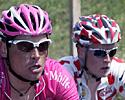
Recently on Cyclingnews.com |
Tour de France Tech – August 14, 2005
Edited by John Stevenson
Got tech? Send press releases, news, and tech questions to the Cyclingnews tech desk.
More on the eye-war:
Specialized claims 'lightest-ever'; DaveZ and CSC use Smith; Extra-tough Rudy Project

|
Following on from last month's TdF Tech item on the latest 'market-share' among professionals who are - admittedly - paid to wear particular brands of eyewear, comes more information from eye-wear companies that are fighting for your attention.
Specialized has set off a bomb with its new Arc model, weighing in at an astonishingly-light 16 grams.
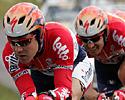
|
The California-based company is a significant new player in this hyper-competitive market. It entered the field this year with its 'Adaptalite' photochromic products and as previously reported, the company already accounts for 11 percent of the TdF field thanks to its sponsorship of the Domina Vacanze and Davitamon-Lotto teams (such as Fred Rodriguez) and Gerolsteiner riders Levi Leipheimer and Michael Rich, as well as Daniele Nardello (T-Mobile). Both the Davitamon-Lotto and Domina Vacanze squads are also using Specialized helmets.
Specialized-ponsored riders are using the Arc and new Helix models. As highlighted, the Arc weighs only 16 grams, which gives Specialized the ammunition to claim the Arc is "the lightest-eyewear-on-the-planet". Specialized designers started with a recently declassified military lens material, NXT.
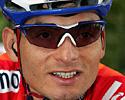
|
"After augmenting this shatter-proof polymer with color-changing Adaptalite photochromic die - which allows the lenses to automatically adapt to a wide range of light conditions - they added two ergonomically tuned titanium temples and a slim hydrophilic nosepiece," said a Specialized spokesperson.
The eyewear is specifically made for riding, so the optics have been tuned for "virtually distortion-free performance" while cycling. To minimise refraction, engineers tuned the pantoscopic angle (the vertical orientation of the lens relative to the eye) of the optics for clear vision when in a range of common cycling positions.
"The guys at Specialized have done a lot of work on something that's so easy to forget," said Leipheimer.
The only problem with the Arc is that they are single-piece, in that the frames are not articulated. While they do come with a sturdy protective hard-case, some riders may prefer more conventional eye-wear that would be easier to slip inside a jersey pocket.
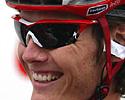
|
There are other models in the range, such as the Helix - favoured by Rodriguez and a swag of other pros - as well as the San Remo, Cortina and Half-Time. These all fold down into a much smaller package. For further information, see Specialized's website.
(Specialized was also a prize sponsor of the Cyclingnews le Tour Fantasy Game - with a pair of either the new Arc or Helix models were on offer as the daily stage prize. Check out who won and then track them down, because the inverse law of eye-wear ownership means that the more valuable the sunnies, the greater the chance they get left behind. For some reason, your cheap, throw-away jobs just seem to follow you around the world. Ed)

|
DaveZ looking cool in Smith
Another eyewear maker that enjoyed a very high profile wearer at the Tour de France was Smith Optics, as its products have been worn by Dave Zabriskie and other members of Team CSC.
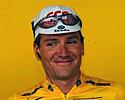
|
While Smith has a strong presence in the lifestyle, alpine and MTB markets, this year it has made a serious tilt at the road market with a range of road-cycling specific products (first seen in New Arrivals in February this year). The Smith eyewear uses an interchangeable 'TLT Carbonic' lens system for variable light conditions, while an adjustable wire nose with a hydrophilic nose pad allows for personalized fit.

|
One of the Smith models chosen by Team CSC is the Frontline Max, a medium-fit rimless design that has over a dozen replacement lens tints to accommodate a wide variety of light conditions, as well as 100 percent UVA and UVB protection.
Smith has also released the Frontline II that has been redesigned to increase the field of view and decrease weight, an adjustable nose-piece, increased head-curve to accommodate a wider range of wearers.
In fact, Smith was offering a choice of the limited edition Team CSC Frontline, Frontline Max, the Theory or the Theory Max in a prize competition during the Tour de France. Check out the details at www.smithoptics.com.
|
|
|
|
|
Jan & co. wear tougher Rudy Project
One of the more recognisable wearers of sunglasses has to be Jan Ullrich and his 'man-machine' look in Rudy Project.
At the Tour, 'Der Kaiser' and many other sponsored riders were equipped with new 'ImpactX' sunglasses that also feature the 'NXT' polycarbonate lens material.
In fact, Rudy Project equipped 45 riders this year - 24 percent of the TdF peloton. Apart from Ullrich, other wearers include all of the Rabobank and Lampre-Caffita teams; most of Saunier Duval (Juan Manuel Garate, David Canada, Nicolas Fritsch, Christopher Horner, Leonardo Piepoli, and Manuel Quinziato); most of FDJ (Bradley McGee, Baden Cooke, Carlos Da Cruz, Bernhard Eisel, Philippe Gilbert, and Thomas L÷vkvist); Laszlo Bodrogi (Credit Agricole); Thierry Marichal and CÚdric Vasseur (Cofidis); and Robert F÷rster (Gerolsteiner).
Promotional material for the new 'ImpactX' sunglasses shows the lens being attacked with hammers and even .44 calibre bullets - and neither are able to penetrate the flexible lens material. 'NXT' was developed in the USA in '90s after the US Government contracted Simula Technologies to develop a new bullet-proof, transparent and lightweight material capable of providing better protection than existing polycarbonate. The material is now widely used in defence and aerospace applications.
Apart from being bullet-proof, the lens material is also photocromatic, so the one lens can suit a wide range of light conditions. Also, Rudy Project is offering a lifetime guarantee on the new 'ImpactX' lenses. Models in the Rudy range that now feature these lenses include Keytum, Rydon, Kalyos, Ekynox and the Exception Flip-Up. For more, info, see Rudy Project.



